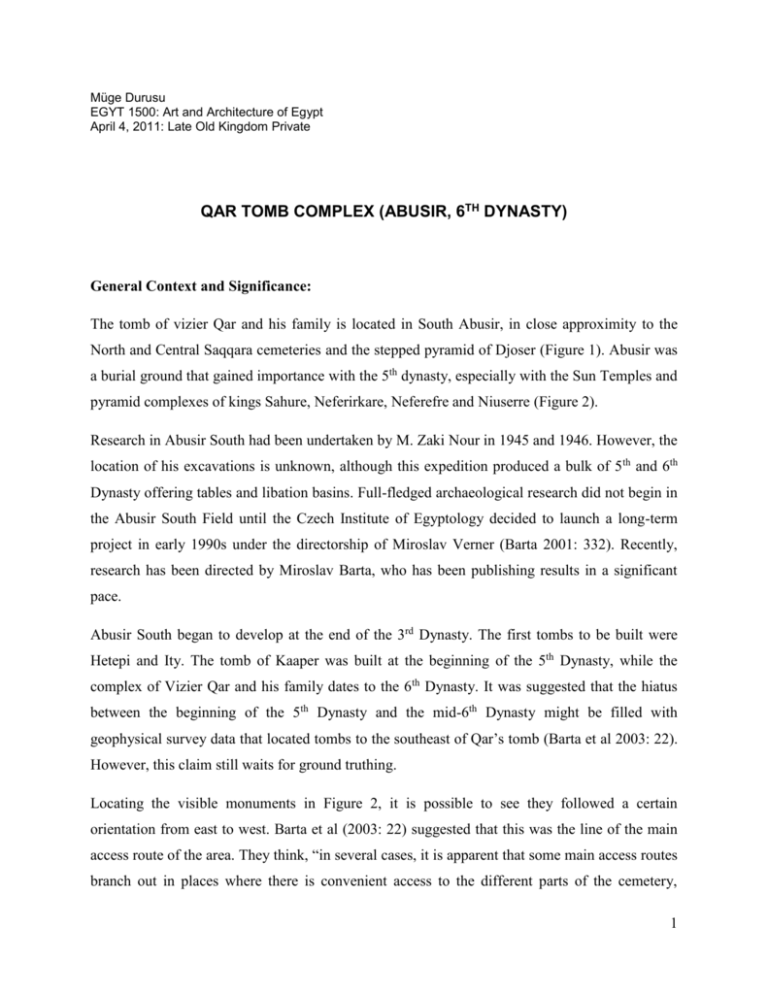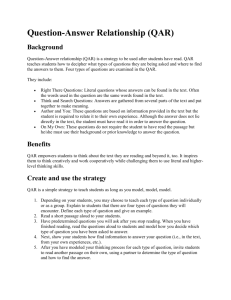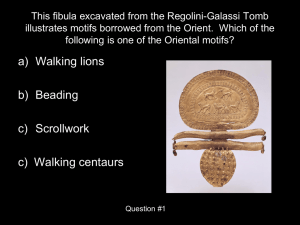Tomb of Qar
advertisement

Müge Durusu EGYT 1500: Art and Architecture of Egypt April 4, 2011: Late Old Kingdom Private QAR TOMB COMPLEX (ABUSIR, 6TH DYNASTY) General Context and Significance: The tomb of vizier Qar and his family is located in South Abusir, in close approximity to the North and Central Saqqara cemeteries and the stepped pyramid of Djoser (Figure 1). Abusir was a burial ground that gained importance with the 5th dynasty, especially with the Sun Temples and pyramid complexes of kings Sahure, Neferirkare, Neferefre and Niuserre (Figure 2). Research in Abusir South had been undertaken by M. Zaki Nour in 1945 and 1946. However, the location of his excavations is unknown, although this expedition produced a bulk of 5 th and 6th Dynasty offering tables and libation basins. Full-fledged archaeological research did not begin in the Abusir South Field until the Czech Institute of Egyptology decided to launch a long-term project in early 1990s under the directorship of Miroslav Verner (Barta 2001: 332). Recently, research has been directed by Miroslav Barta, who has been publishing results in a significant pace. Abusir South began to develop at the end of the 3rd Dynasty. The first tombs to be built were Hetepi and Ity. The tomb of Kaaper was built at the beginning of the 5th Dynasty, while the complex of Vizier Qar and his family dates to the 6th Dynasty. It was suggested that the hiatus between the beginning of the 5th Dynasty and the mid-6th Dynasty might be filled with geophysical survey data that located tombs to the southeast of Qar’s tomb (Barta et al 2003: 22). However, this claim still waits for ground truthing. Locating the visible monuments in Figure 2, it is possible to see they followed a certain orientation from east to west. Barta et al (2003: 22) suggested that this was the line of the main access route of the area. They think, “in several cases, it is apparent that some main access routes branch out in places where there is convenient access to the different parts of the cemetery, 1 which are always dominated by one of the principal tombs (Mastaba MM, Hetepi, Ity, Mastaba KK, Kaaper, Qar). These routes are always laid out so as to come from the southwestern side of the Abusir Lake towards the cemetery, i.e. towards the southwest” (Barta et al 2003: 26). This claim situates Abusir South tombs as landmarks in addition to their burial function, and adds one more layer to their meaning. Tomb Complex of Qar – Architectural Configuration: As stated above, the Tomb Complex of Qar dates to the 6th Dynasty. The complex hosts two burial chambers for Qar himself, three minor chapels for his sons Qar Junior, Senedjemib and Tjenty, and a neighboring separate tomb for his son Inty; all of whom are represented and labeled on the reliefs of the chapel of Qar (Figure 3) (Barta 2006: 49). The tomb complex has a complex architectural configuration (Figure 4). The open court on the north is a dominant feature of the plan, and this space provides access to the long corridor of the cult niches for the minor burials, the subsidiary chapels of Qar Junior, Senedjemib and Tjenty as well as the two burial chambers of Qar himself. Barta (2006: 47) situates this plan as the outcome of a tradition dating to the beginning of the 6th Dynasty, when families of high officials began to dominate most of the central administration. These families constructed large family tombs with a specific typology, including “east-west oriented cult chapels, large cultic courtyards, store rooms and elaborate burial chambers, sometimes decorated”. However, it is possible to find parallels predating the Tomb Complex of Qar. One example is the mastaba of Ptahshepses, a vizier of Niuserre, in Abusir dates to the 5th Dynasty and reflects many of the same architectural ideas of the Qar tombs such as an open court acting as the entrance of both the cult niches and the burial chambers (Figure 5). The tomb complex hosts two burial chambers located on the extension of the same corridor (Figure 6). This duality, when evaluated together with the decorative scheme of the chambers, led scholars to conclude that Qar was a judge, and was promoted to the office of viziership late in his career. The first chamber is inscribed with the title “the true judge of Nekhen”, which only appears in this chamber within the complex (Barta 2006: 49). The larger Chamber II has a more elaborate decorative scheme, which was interpreted as a later addendum to the complex when the first chamber proved to be inadequate upon the promotion of Qar as the vizier. The difference in 2 the false doors of these two chambers has been taken as a point proving this hypothesis (Figure 7). Whether this scenario is true or not, the Judge of Nekhen was a significant title by itself, first attested in the Late Old Kingdom. Given to middle-ranking men during the Old Kingdom and the FIP, the Judge of Nekhen re-emerged in the New Kingdom as one of the highest titulary, given to the viziers of the time (Callender 2000: 362-63). Decoration: Chamber II of Qar was fully decorated, as opposed to Chamber I. The reliefs were rather roughly executed, and most probably by a multitude of artists with different skills. The eastern wall of the chamber showed piles of offerings and had butchering scenes on the lower register. The top registers of the north and south walls showed processions of offering bearers and piles of offerings. The south wall also had scenes of an offering ritual. The western ends of both the north and the south walls had the seated figure of Qar behind the offering table (Figure 8) (Barta 2006: 46-50). One unique feature of the decorative scheme is the depiction of the male figures dragging vessels on the western wall of the entrance area in Chamber II (Figure 9) (Barta 2006: 52). Subsidiary Chapels: Subsidiary Chapels were located to the northeast of the Open Court in the Tomb Complex (Figure 4). These were mainly dedicated to the three sons of Qar, namely Qar Junior, Senedjemib and Tjenty. They yielded a wealth of finds, as exemplified in Figure 10 and Figure 11. Tomb of Inty: The other son of Qar had a separate tomb adjacent to his father (Figure 12). The architecture and the decorative scheme is clearly related to the tomb of Qar, and these two structures must be built almost simultaneously. The low relief decoration of the tomb of Inty, however, is rendered in a more skilled fashion than the workmanship of the tomb of Qar (Figure 13, Figure 14, Figure 15). 3 Figures Figure 1 Satellite image of South Abusir with North and Central Saqqara cemeteries (after Barta 2006: fig.1) 4 Figure 2 Map of the Abusir Necropolis (after Barta 2002 fig. 7) Figure 3 Vizier Qar and his sons (after Barta 2002 p. 38) 5 Figure 4 Ground plan of the tomb complex of Qar (after Barta 2006 fig. 2) 6 Figure 5 Groundplan of the mastaba of Ptahshepses, vizier of Niuserre. Fifth Dynasty, Abusir (after Balik and Vachala 2001 fig. 1) 7 Figure 6 Burial chambers of Qar 8 Figure 7 The false doors in the tomb of Qar. Before he was assigned as the vizier (on the left) and after he was assigned as the vizier (on the right) (after Barta 2002 figs. 23 and 24) 9 Figure 8 Qar sitting in front of offerings. From the second chapel (after Barta 2002 fig. 22) Figure 9 Detail of men dragging vessels (after Barta 2006 fig. 6) 10 Figure 10 Offering tools from the chapel of Qar Junior (after Barta 2002 fig. 33) Figure 11 The tablet of the seven sacred oils from the chamber of Senedjemib (after Barta 2002 fig. 38) 11 Figure 12 Plan of the complex showing the tomb of Inty in relation to that of Qar 12 Figure 13 Offering scene from the southern wall of the chapel of Inti (after Barta 2002 fig. 26a) Figure 14 Reconstructed entrance to the tomb of Inty (after Barta 2002 fig. 26b) 13 Figure 15 False door of Inty (after Barta 2002 fig. 30) 14 Bibliography (Annotated): Balik, M., and B. Vachala. 2000. “The Scientific Restitution of Ptahshepses’ Mastaba at Abusir – an Ideal Reconstruction.” In M. Barta and J. Krejci (eds.) Abusir and Saqqara in the Year 2000. Prague: Academy of Sciences of the Czech Republic, pp. 317-330. Detailed account on the Ptahshepses Mastaba at Abusir. This article was useful in terms of providing comparanda material for the Tomb Complex of Qar. Barta, M. 2002. Memories of 4500 Years Ago. Catalogue for the exhibition with the same name. Not a highly academic source, but an easy read with good quality and colorful visual material. Barta, M. 2006. “The Sixth Dynasty Tombs in Abusir. Tomb Complex of the Vizier Qar and His Family.” In The Old Kingdom Art and Archaeology, M. Barta (ed.). Prague: Publishing House of the Academy of Sciences of the Czech Republic. This paper was the most useful source for the Tomb Complex of Qar. It is an extensive and detailed account of the architectural setting and its associated finds. Its most significant disadvantage is its black-and white photographs, which fortunately can be replaced through other publications. Barta, M., Bruna, V., and R. Krivanek. 2003. “Research at South Abusir in 2001-2002 – Methods and Results.” In Památky Archeologicke XCIV. Prague: Archaeological Institute, pp. 49-82. This article mainly concentrates on the geophysical work carried out in the Abusir cemetery, but does a good job of bringing in the results of this research into the larger social context. Its most important use, of course, is the information it offers for “filling in the gaps” between the visible monuments of Abusir through resistivity survey. 15 Callender, V. G. 2000. “A propos the Title of r Nhn n z3b.” In M. Barta and J. Krejci (eds.) Abusir and Saqqara in the Year 2000. Prague: Academy of Sciences of the Czech Republic, pp. 361-380 A detailed study on the history and the social significance of the title “Judge of Nekhen”, which appears on the wall of Chamber I of Qar. This office is assumed to be held by Qar prior to become a vizier. Czech Institute of Egyptology Website (http://egyptologie.ff.cuni.cz) Czech Institute of Egyptology is the leading institute involved in the expeditions in Abusir. This website is a decent place to start, with a whole catalogue of publications (a few are also available online as e-books!). “Abusir XIII : tomb complex of the vizier Qar, his sons Qar Junior and Senedjemib, and Iykai” was published in 2010, but unfortunately this volume did not arrive at the Brown library yet. Since I could not have it on time through the ILL either, I could not use this book. However, it seems to be an invaluable source. 16








